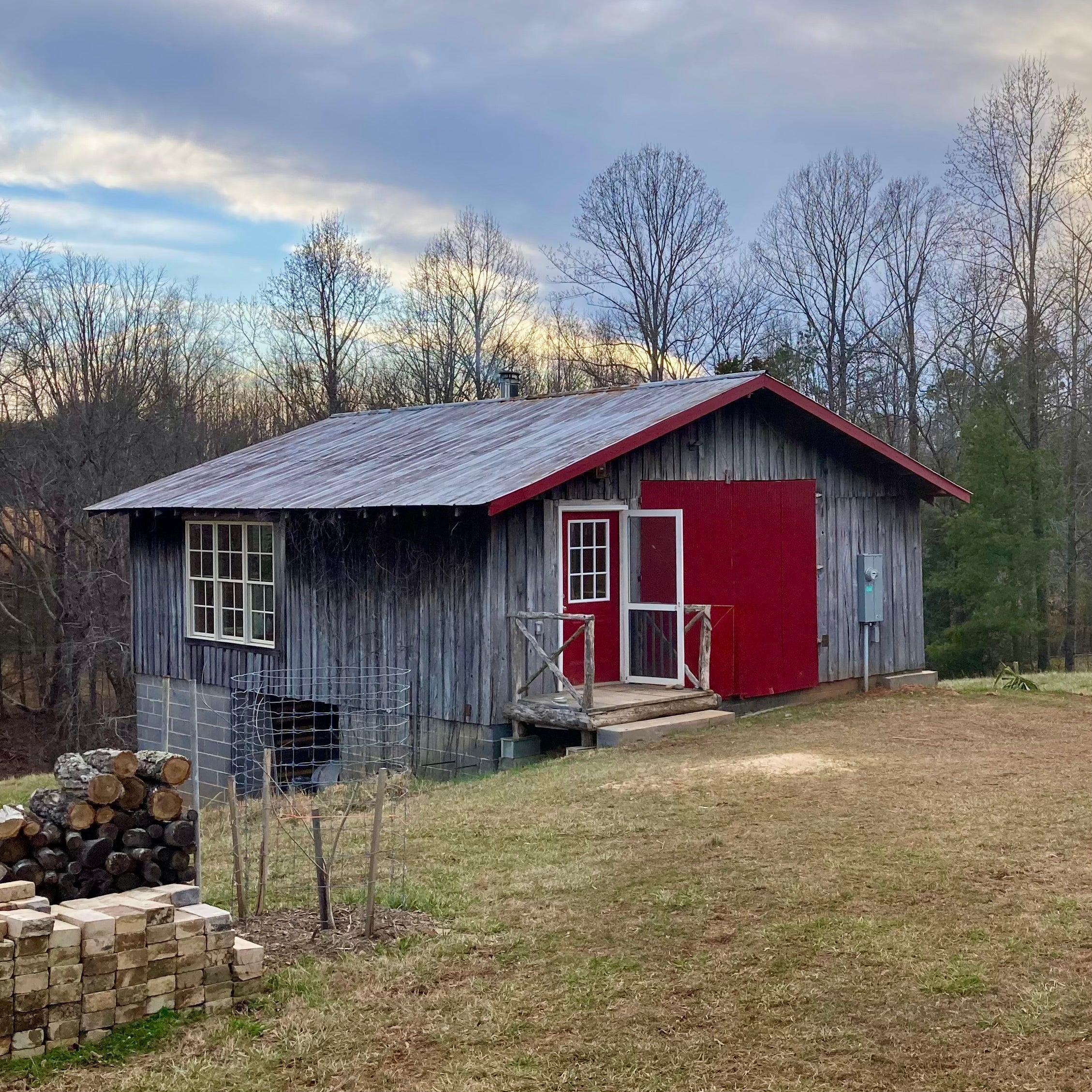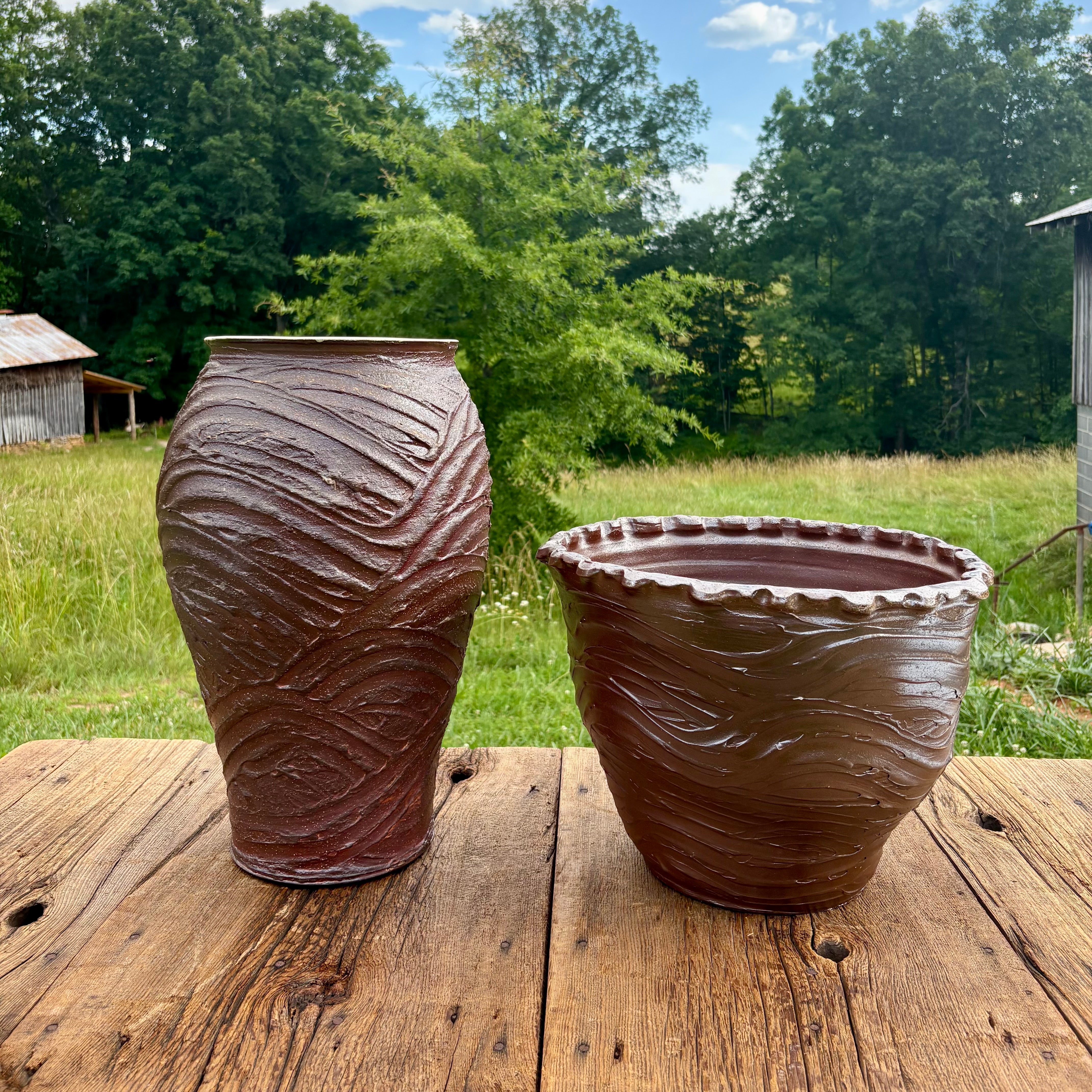From Barn to Studio: A Rural Space for Pottery
Published: April 2, 2025 | Reading Time: 5 minutes
When I first purchased my farm in Stokes County, its many outbuildings told the story of farm life past – barns covered in vines and overgrown fields. Where some would have only seen the enormity of the project, I saw land and structures where creativity could flourish.
Finding Potential in Forgotten Spaces
I decided to build my shop in an old stick framed livestock barn that was built into the side of a hill. I figured it would be easier to wire and cut windows into than the log tobacco barns I had. The barn looked rough but the roof was decent and hadn’t started to leak yet. We would later find that the hill had pushed the concrete block foundation and would need major repairs.
 The barn as we found it – nearly reclaimed by nature but with good bones underneath
The barn as we found it – nearly reclaimed by nature but with good bones underneath
Planning with Purpose
I wanted to preserve the barn's rustic character while creating a functional workspace that would accommodate a fully functional pottery studio. I needed some natural light, space for materials and equipment, storage, and clay preparation.
The priorities were clear:
-
Reinforce the structural elements without losing character
-
Install electrical for lights, pottery wheels, electric kilns, etc.
-
Create abundant natural light with strategically placed windows
-
Repair the roof and install a wood stove.
-
Design a flow that separated wet and dry processes
 The interior is ready for transformation.
The interior is ready for transformation.
The Transformation Process
The renovation began with clearing overgrowth and exposing the barn's true structure. Once we could see what we were working with, we began with the repairs.
 Preparing to pour the new footing.
Preparing to pour the new footing.
 The structure was well supported after footings were poured.
The structure was well supported after footings were poured.
After we poured concrete reinforcing walls to better support the structure and stave off further movement of the foundation, an electric service was added for wheels, kilns, and lighting. We also installed large windows that we got at the habitat restore in Greensboro, which provide views onto the surrounding fields to the east, south, and west.
 Large windows (and insulation) were installed to allow for natural light, air flow, and connection to nature.
Large windows (and insulation) were installed to allow for natural light, air flow, and connection to nature.
The pine boards that cover the interior walls are from timber we harvested, milled and dried ourselves. The natural variations in the wood grain create a visual texture that complements rather than competes with the pottery being created inside.
 Pine boards, large windows, log rafter supports, ample electrical outlets, and plentiful overhead lighting.
Pine boards, large windows, log rafter supports, ample electrical outlets, and plentiful overhead lighting.
As you might hear if you are in rural North Carolina, "a building is only as good as its roof." To ensure our roof would stand up to the weather, we repaired it and added a pass through for a wood stove to heat the studio in the winter.
 Adding a pass through box for a double wall chimney pipe.
Adding a pass through box for a double wall chimney pipe.
To allow for an area to make and store clay and other supplies, we repaired the concrete block support wall, and thanks to a grant from the local arts council, we were able to plumb the studio for water necessary to mix clay and slips.
 Repairing the cinderblock wall for a secure foundation.
Repairing the cinderblock wall for a secure foundation.
 Digging the trench for installation of the water line.
Digging the trench for installation of the water line.
Connecting to Tradition
This studio renovation intentionally connects with the wood-fired kiln we built nearby (detailed in my previous post). The proximity allows me to move pieces efficiently from creation to firing, and the complementary designs of the two structures create a cohesive pottery compound.
The completed studio is now fully functioning, and the space accommodates multiple pottery wheels, extensive shelving for works in progress, and all the tools needed for a professional pottery practice.
 The completed studio (left) with red door
The completed studio (left) with red door
The Journey Continues
Transforming this barn into a working pottery studio has been about more than just renovation – it's about honoring rural crafting traditions while creating space for their continuation. This building, once used for agricultural purposes, now nurtures a different kind of cultivation: that of creativity and craft.
The studio is the heart of my ceramic practice. Like the wood-fired kiln nearby, this space connects past and present, creating a link in the long chain of North Carolina pottery tradition.
____________
Studio visits are welcome by appointment for those interested in seeing both the studio and our wood-fired kiln in action.




